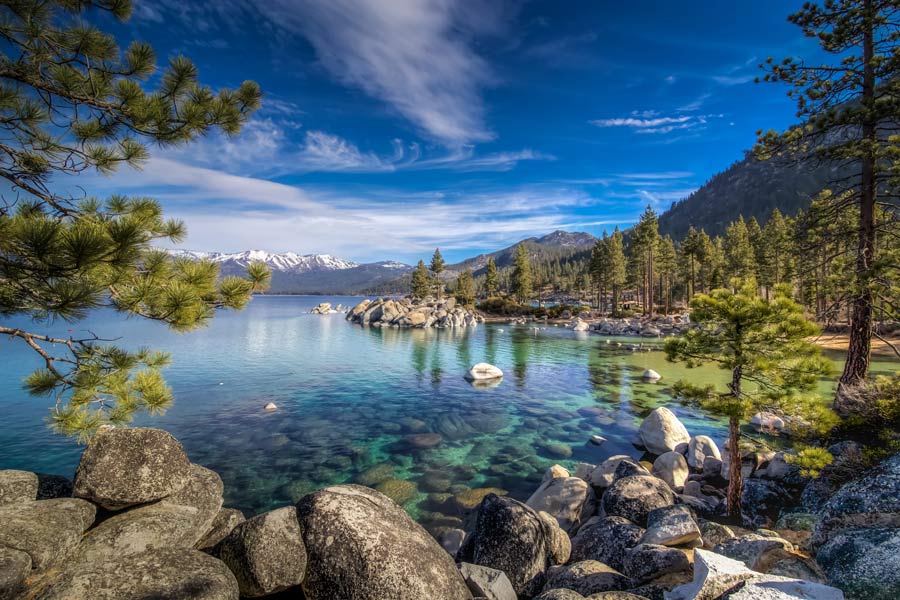What does our water picture look like after this winter?: ‘this year is a lesson’

Hannah Pence / Tahoe Daily Tribune
GREATER LAKE TAHOE AREA, Nev. / Calif. – April 1 marks an important milestone for snowpacks and water supply forecasts as the date basin snowpacks typically reach a peak before melting. However, a wave of warm temperatures late March started the melt early, adding a caveat to April 1 measurements.
According to the USDA’s Natural Resources Conservation Service’s (NRCS) Nevada Water Supply Outlook Report, snowpacks in the eastern Sierra basins would have exceeded normal peaks had the warm weather not decreased the snow totals ahead of the end of March through early April storms.
The warm temperatures the region saw between March 21-27 gave snowmelt a head start this year. NRCS recorded the average air temperature at 48 degrees Fahrenheit on March 26 across their monitoring sites in the Sierra Nevada. This temperature was close to the record for that date. Shortly after, winter decided it wasn’t over yet.
“False spring came to a screeching halt on March 28 and snow returned to the mountains through April 1,” the report states.
With the give and the take, the April 1 snowpack for the Lake Tahoe basin is just shy of normal at 95%. The Truckee basin’s snowpack was able to rise just above normal at 103%. Neither basin quite measured up to the snowpack of last year and didn’t come close to the record totals in 2023. That’s despite the seasonal precipitation accumulation from October through March being just above normal.
According to the California Department of Water Resources (DWR), snow monitoring sites across the Truckee and Tahoe basin are also reporting snowpacks near or just above average April 1 totals.
Water supply forecasters, including those for both NCRS and DWR use data from the April 1 snowpack to determine how much snowmelt runoff will ultimately make its way into rivers and reservoirs.
On average, California’s snowpack supplies about 30% of California’s water needs.
“It’s great news that our state’s snowpack has recovered from several weeks of extremely dry conditions in the heart of our winter storm season,” said DWR Director Karla Nemeth. “However, it’s not a wet year across the entire Sierra Nevada. The north has great snowpack, but snowpack is less than average in the central and southern part of the mountain range. That snowpack ultimately flows to the Delta, and the regional disparity affects how much water the State Water Project will be able to deliver.”
While the snowpack across California has caught up to near normal overall, DWR reports much of southern California remains exceptionally dry and below average for rainfall. That trend is similar for southern Nevada with data alerting an extreme and exceptional drought for the region which received substantially less precipitation this water year and snowpack accumulation than its northern counterparts.
Reservoir storage for northern Nevada is in good shape with most reservoirs storing near normal or well above normal amounts. That goes for Tahoe and Truckee basin reservoirs. Lake Tahoe is expected to fill to 93% capacity this year.
Boca and Prosser are expected to fill, while Stampede may come close at 90% capacity.
Marlette Lake is an exception due to a drawn down of 20 feet for major work planned on its dam.
“From major storms in November and December to a bone-dry January, then back to major storms in February and March,” Andy Reising, manager of DWR’s Snow Surveys and Water Supply Forecasting Unit says, “this year is a lesson in why we can never know for certain what our water picture will look like until we get to the end of our traditional wet season.”

Support Local Journalism

Support Local Journalism
Readers around the Lake Tahoe Basin and beyond make the Tahoe Tribune's work possible. Your financial contribution supports our efforts to deliver quality, locally relevant journalism.
Now more than ever, your support is critical to help us keep our community informed about the evolving coronavirus pandemic and the impact it is having locally. Every contribution, however large or small, will make a difference.
Your donation will help us continue to cover COVID-19 and our other vital local news.











